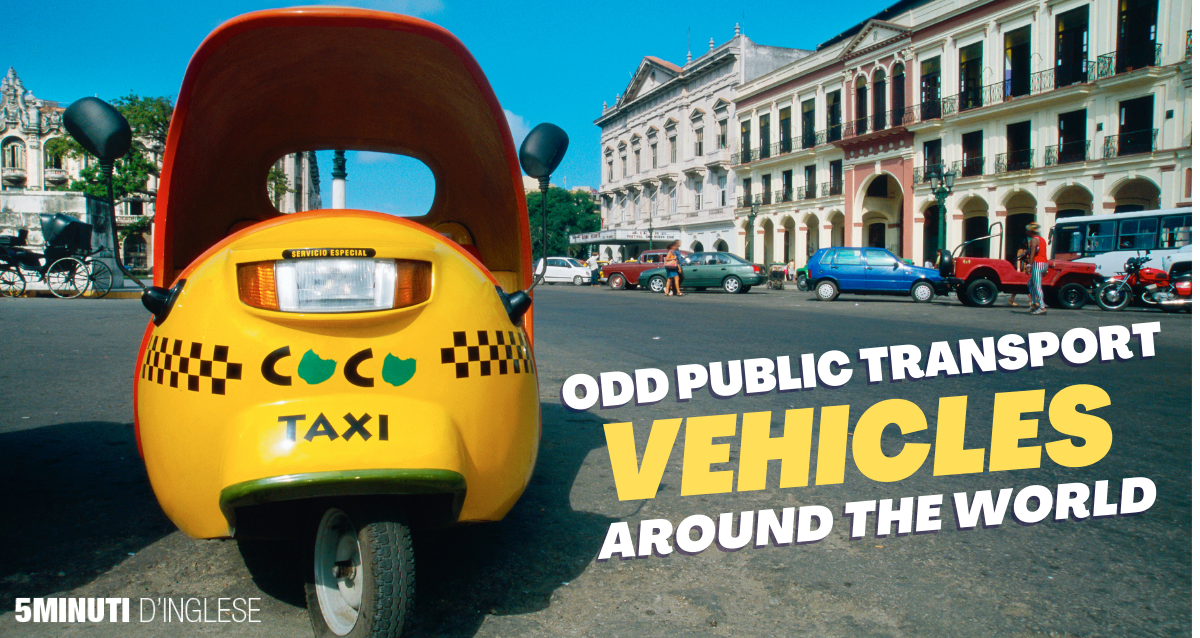In most countries in Europe and North America, public transportation is relatively standard: undergrounds, buses, trams, and taxis help people get around the city, from work to home, and even across the country. Around the world, however, countries have developed unique ways to help their citizens get around. Let’s see some of their most unique vehicles!
Jeepney buses, Philippines
The jeepney is an integral part of the Philippine culture and is common in Manila and some other big cities in the country. Today’s jeepneys have multicoloured paint and are embellished with numerous trinkets, including tassels and lights, but this wasn’t always the case. The remarkable history of this unique mode of public transit goes all the way back to the American occupation of the Philippines during World War II.

The American military gave the villagers the last military Jeeps it had after the war. These Jeeps were disassembled, remodelled, and given extensions by the locals to make them a cheap form of public transportation. As time went on, jeepney manufacturing businesses started to spring up all throughout the nation, specialising in creating unique jeep-bus designs.
Despite objections from drivers and low-income residents over the past few years, former Philippine President Rodrigo Duterte has attempted to phase out Jeepneys. Rather than Jeepneys, President Duterte wanted to replace them with contemporary, eco-friendly cars that look more like buses. This change is meant to make public transportation easier to use, cut down on pollution, and make things safer.
Camel buses and Coco taxis, Cuba
Since the 1990s, visitors travelling to Cuba have frequently used coco taxis as a form of transportation. The taxis get their name from their bright yellow, coconut-shaped shells made of fibreglass and welded onto Piaggio scooters. You may find them in major Cuban cities like Havana, Veradero, and Trinidad.
Those in the auto industry may be familiar with Cuba’s iconic “camel buses,” a cross between a trailer tractor and a bus that can accommodate 200–300 passengers at once. The austerity period that Havana experienced following the fall of the Soviet Union in the 1990s is symbolised by these camel buses. Locals in Cuba who are compelled to ride these buses have expressed their hatred for them, complaining that they are packed, hot, and have terrible ventilation.
As of right now, the outdated camel buses are gradually being replaced by contemporary Yutong buses imported from China.
The Schwebebahn, Germany
Take a ride on the Schwebebahn suspension railway, which winds over Wuppertal and its tributaries, the next time you’re in Germany. In use since 1901, the recognisable monorail carries roughly 85,000 riders each day.
The railway is particularly well-known for a 1950 incident with the elephant Tuffi from the local circus. As part of an advertising stunt, a circus elephant was riding the monorail when it lost control, crashed out a window, and survived a 39-foot fall into the river.
Monte Toboggan, Portugal
One of Madeira’s most renowned sights is the Monte Toboggan. The Monte Sledge, a wicker toboggan, was the main mode of public transportation for travelling downhill in Funchal (the capital of Madeira) until the 1850s.
The “Carro de Cesto” has been entertaining and transporting tourists from the Nossa Senhora do Monte Church steps downhill to Livramento, a suburb of Funchal, for many years.
On this downward journey, two men known as “Carreiros,” who are clothed in white and sporting straw hats, will serve as your drivers. They wear special shoes with rubber soles (that glide on greased-up rags) to manoeuvre and brake the toboggan, which is essentially a rattan basket fastened to two wooden runners.
Bamboo trains, Cambodia
The Nori, or Cambodian bamboo trains, consist of an electric generator and a temporary bamboo platform used for seating. They travel at up to 40 km/h along the railroad tracks. The ride may be bumpy due to the poorly maintained tracks, but the prices are reasonable, and it is a once-in-a-lifetime opportunity.

These bamboo “trains” are made up of a 6-by-10-foot bamboo board supported by two axles and wheels that are welded onto the axles. The accelerator and brakes are on a wooden pole. The simplicity of the Nori is crucial because they only have one track to go on, which means that if two of them meet head-on, drivers and passengers must disassemble their carriages to make room for one another to pass. It just takes a minute to disassemble the bamboo plank because it is placed on the axles and wheels rather than being drilled together, making it a quick but somewhat risky mode of transportation.
Maglev, China
The Maglev, short for magnetic levitation, is not a typical airport train. With a top speed of 431 km/h, it can travel the 30 kilometres to Pudong Airport in just 7 minutes, using magnetic repulsion to hold itself just inches above the track.
On the Shanghai Maglev train, magnets are used in place of the conventional steel wheels and rails. Because there are no wheels or motors, the train is frictionless and can travel at an incredible speed. Due to the lack of moving parts, this environmentally friendly train is quiet, consumes less energy than standard trains, and continues to run smoothly in bad weather.
| public transportation | trasporto pubblico |
| tram | tram |
| integral | integrale |
| to be embellished | da abbellire |
| trinket | gingillo |
| tassel | nappina |
| occupation | occupazione |
| military | militare |
| to disassemble | smontare |
| to remodel | rimodellare |
| to spring up | spuntare |
| objection | obiezione |
| resident | residente |
| former | ex |
| to phase out | eliminare gradualmente |
| contemporary | contemporaneo |
| pollution | inquinamento |
| bright | luminoso |
| fibreglass | fibra di vetro |
| camel | cammello |
| trailer tractor | trattore a rimorchio |
| austerity | austerità |
| compelled | costretto |
| packed | imballato |
| ventilation | ventilazione |
| suspension railway | ferrovia sospesa |
| tributary | affluente |
| advertising stunt | trovata pubblicitaria |
| renowned | rinomato |
| wicker | vimini |
| toboggan | slittino |
| straw hat | cappello di paglia |
| sole | suola |
| brake | freno |
| runner | corridore |
| temporary | temporaneo |
| bumpy | sconnesso |
| axle | asse |
| accelerator | acceleratore |
| head-on | frontale |
| risky | rischioso |
| repulsion | repulsione |
| conventional | convenzionale |
| frictionless | senza attrito |







